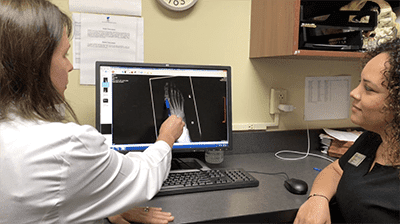What is Ankle Arthritis?
- What Are the Types of Arthritis?
- What Are Surgical Treatment Options for Arthritis?
- What is Total Ankle Replacement?
Ankle arthritis is the inflammation of one or more joints in the ankle, which generally results in pain, swelling, stiffness and limited movement. There are more than 100 different types of arthritis, many of which affect the small joints of the foot and ankle.
Ankle arthritis, and arthritis in general, is characterized by a thinning of the protective joint surface cartilage, which produces bone-on-bone friction, swelling and pain. You may have difficulty walking, getting up from a seated position, or moving around first thing in the morning. Walking up steps, ramps or uneven surfaces may also be challenging.
Although no cure for arthritis exists, many treatment options are available to hinder the progress of the disease and alleviate symptoms. With proper treatment, many people with arthritis are able to manage their pain, stay active and lead fulfilling lives.
What Are the Types of Arthritis?
The major types of arthritis that affect the foot and ankle are osteoarthritis, rheumatoid arthritis, and post-traumatic arthritis.
Osteoarthritis
 Osteoarthritis is a degenerative joint disease where the cartilage covering the bones wears away slowly. As the cartilage erodes, it becomes frayed and rough, and the protective space between the bones diminishes. Ankle osteoarthritis can be caused by a previous ankle injury or the natural wear and tear on the joint as you age. Injury can damage the cartilage directly, or it can alter the mechanics of the ankle joint.
Osteoarthritis is a degenerative joint disease where the cartilage covering the bones wears away slowly. As the cartilage erodes, it becomes frayed and rough, and the protective space between the bones diminishes. Ankle osteoarthritis can be caused by a previous ankle injury or the natural wear and tear on the joint as you age. Injury can damage the cartilage directly, or it can alter the mechanics of the ankle joint.
Other risk factors may contribute to the development of osteoarthritis, including obesity and family history. Being overweight can add weight to bearing joints, including the ankle. Genetics may also play a role in advancing the disease. For example, being flat-footed may affect how you walk and add stress to the ankle joint.
Rheumatoid Arthritis
Rheumatoid arthritis is a chronic, autoimmune disease affecting numerous joints throughout the body; the condition often begins in the foot and ankle. It is symmetrical, meaning it typically impacts the same joint on both sides of the body.
With rheumatoid arthritis, the cells of the immune system attack the synovium covering the joint, causing it to swell. This leads to damage to the bones, cartilage, ligaments and tendons. Over time, the structure of the ankle joints can be affected, leading to disability and permanent changes in the shape of the joints.
The causes of rheumatoid arthritis are unclear. Some researchers believe that specific genes may make people more susceptible to the disease. Often infection or specific environmental factors act as a trigger to activate the genes.
Post-traumatic Arthritis
Post-traumatic arthritis is caused by the wearing out of a joint that has had a physical injury. The injury could be from sports, dance, a car accident, a fall, or any other source of physical trauma. Dislocations and fractures, especially those that damage the ankle joint surface, are the most common injuries that lead to post-traumatic arthritis. The disease can manifest many years after the initial injury.
What Are Surgical Treatment Options for Arthritis?
If conservative approaches are unsuccessful, surgery may be the best option. The kind of procedure you require will depend on the type and location of arthritis and the impact of the disease on your joints. There are two types of surgery for ankle arthritis: ankle fusion and total ankle replacement.
Ankle fusion
 Ankle fusion, known as arthrodesis, has been the gold standard treatment for ankle arthritis. During ankle fusion, the damaged cartilage is removed and the ankle aligned at ninety degrees. Pins, screws, or a plate are then inserted to hold the joint in place. Over time, the bones fuse or grow together.
Ankle fusion, known as arthrodesis, has been the gold standard treatment for ankle arthritis. During ankle fusion, the damaged cartilage is removed and the ankle aligned at ninety degrees. Pins, screws, or a plate are then inserted to hold the joint in place. Over time, the bones fuse or grow together.
Arthrodesis is ideal for patients who have:
- Considerable deformity
- Excessive bone loss
- Weak ligaments or poor bone quality
- Previous infection
- Pronounced obesity
- Nerve damage
Patients can walk quite normally after fusion surgery, and rocker shoes may be able to make walking easier. The results from ankle fusion are good, with more than 90 percent of patients reporting they are satisfied. The procedure effectively reduces pain by eliminating motion in the arthritic joint.
What is Total Ankle Replacement?
Total ankle replacement (TAR), or arthroplasty, involves resurfacing the weight-bearing parts of the ankle joint where bones come together. A metal component is placed on the ankle’s upper bone, and a matching metal component is secured to the lower bone. Between these components is a polyethylene liner that helps the ankle glide through its range of motion.
Surgeons often recommend ankle arthroplasty for patients who have:
- Advanced ankle arthritis
- Arthritis that has eroded the joint surface of the ankle
- Severe ankle pain that inhibits routine activities
As opposed to ankle fusion, total ankle replacement preserves ankle motion and function. The ideal candidate for TAR is someone with good bone quality, healthy tendons and ligaments, reasonable alignment, and normal neurologic function.
Ten-year post-procedure studies show positive results for TAR. If an ankle replacement fails, you may be able to have corrective surgery, or you may have the opportunity for a fusion procedure.


